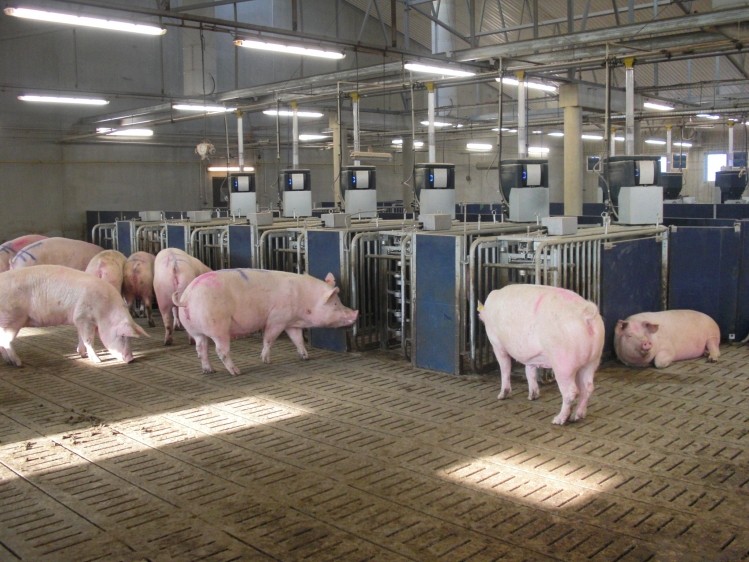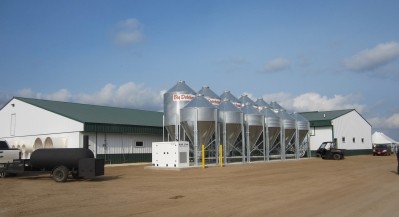Dietary net energy levels may boost feed efficiency

A team of researchers from Sao Paulo State University in Brazil explored the role of dietary energy from crude protein and amino acid supplementation in swine production. The group published its work in the journal Livestock Science.
“This study aimed to investigate the effects of different net energy (NE) levels of diets with reduced crude protein (CP) and supplemented with amino acids on feeding behavior, performance and carcass characteristics of heavy pigs (100–130 kg)."
The team found that dietary energy level could alter feed efficiency and time spent at the feeder.
“This study indicated that feeding heavy pigs with net energy levels of reduced crude protein, amino acid-supplemented diets from 2,388 to 2,563 kcal NE/kg produced the best response,” the researchers said. “Below or above these NE levels in the diets, pigs spent more time at the feeders and presented lower feed efficiency.”
Why dietary energy and heavy pigs?
In swine production, there has been a trend toward raising heavy pigs, said the researchers. The practice allows for producers to optimize higher rates of weight gain and reduces costs.
However, the practice also creates challenges and can make the finishing phase more expensive from increased feed intake, they said. “Furthermore, for pigs with BW [body weight] higher than 90 kg, much of the energy consumed is converted to fat and the consequence is reduced feed efficiency and decreased lean percentage on the carcass,” they said.
Nutritionists are now seeking ways to reduce production costs and improve carcass quality, they said.
“Energy and protein are important nutritional factors affecting carcass quality and represent more than 80% of the nutritional cost of practical diets for pigs,” said the researchers. “Thus, the diet nutrient composition should adequately meet the energy requirements of the animal and optimal amino acid balance.”
To generate the best balance of amino acids many low crude protein diets have used crystalline amino acids, they said. The practice allows for amino acid needs to be filled, while reducing the amount of protein fed.
However, there have been questions about a potential link between lower protein diets and added fat generation, they said. This may mean more adjustments are needed to improve production of heavy pigs and that more information regarding energy use.
“NE is the only system in which energy requirements and diet energy values are expressed on the same basis, which should theoretically be independent of the feed characteristics,” said the researchers. “In this sense, the NE system has attracted the interest of nutritionists mainly considering the reduction of diet costs.”
However, there is little information regarding use of NE with heavy pig production – particularly not when working with a reduced protein diet, they said.
Methods and materials
In the feeding trial, 65 pigs were given one of five diets for a period of 32 days, the researchers said. The pigs also had a 15-day adaptation period where they were fed a commercial corn and soybean meal diet.
The different diets included NE levels of 2,300, 2,388, 2,475, 2,563 and 2,650 Kcal NE/kg, they said. The 2,475 kcal NE/kg was the control diet and all diets were formulated with corn, soybean meal and wheat bran.
“Two diets were formulated to meet the nutritional requirements proposed by the NRC (2012): Diet A (high NE - 2650 kcal NE/kg) and Diet B (low NE - 2300 kcal NE/kg), which served as the basis for the intermediate diets (2388, 2475 and 2563 kcal NE/kg) by mixing the appropriate proportions. The A and B diets were blended at each service to each pig according to the NE level treatment assigned to that animal.”
Feed was available to each animal ad libitum, said the researchers. Feeding habits of each animal were tracked and analyzed.
Animals were weighed on day 0 and day 32, and feed intake was recorded daily, they said. Average daily gain (ADG), average daily feed intake (ADFI), average daily NE intake, feed efficiency (ADG:ADFI) and NE efficiency were calculated.
Images of backfat thickness and loin depth were collected on day 0, they said. Animals were harvested at the end of the experiment and carcasses were evaluated for hot carcass weight, hot carcass yield, backfat thickness, loin depth and loin eye area.
Results
Overall pigs getting the highest with the highest and lowest NE values took more meals per day than those getting other diets, said the researchers. However, pigs getting the 2,388 and 2,475 NE kcal/kg diets spent longer when eating each meal.
“Among the studied levels, 2388, 2475 and 2563 kcal NE/kg produced the best results for reduced CP diets fed to heavy pigs because the pigs occupied the feeders for less time and showed higher feed efficiency,” they said.
Diet did not alter ADFI, however final body weight tended to increase as NE amounts in the diets grew, they said. ADG was similar.
“Animals fed the 2,388, 2,475 and 2,563 kcal NE/kg diets showed similar feed efficiency,” they said. “However, the feed efficiency of pigs fed the 2,563 kcal NE/kg diet was approximately 9% higher than in the groups fed the 2,300 and 2,650 kcal NE/kg diets.”
Hot carcass yield increased linearly as NE amounts rose, said the researchers. Animals getting the lowest NE diet had 1.5% lower yield but other diets were similar.
Loin depth and eye area were not altered, but backfat thickness had a quadratic response to increased amounts of NE in the diet, they said.
Source: Livestock Science
Title: Net energy levels of reduced crude protein, amino acid-supplemented diets for heavy pigs
DOI: doi.org/10.1016/j.livsci.2017.09.014
Authors: C Fracaroli, D Perondi, L Santos, W da Silva, A Veira and L Hauschild













